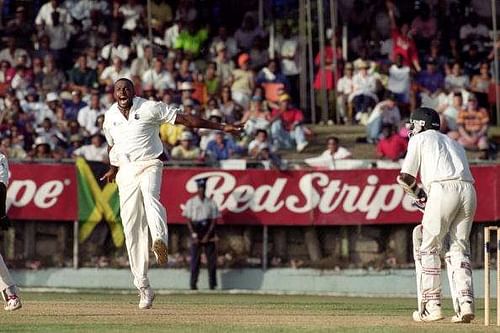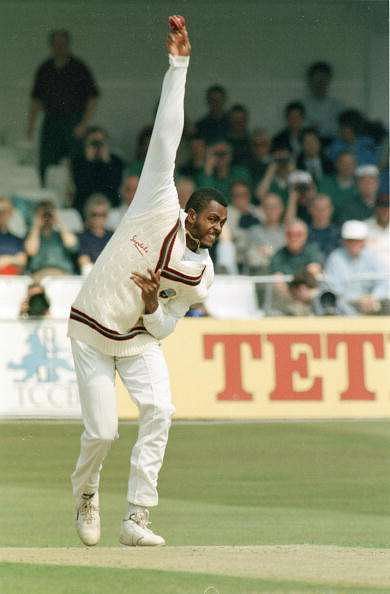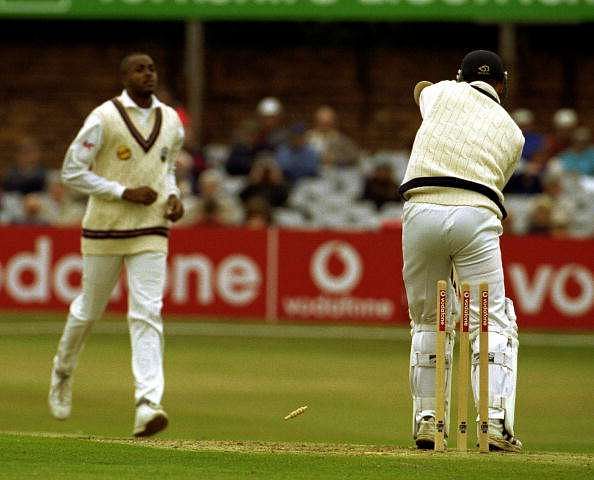
Courtney Walsh: One for the record books

It was 1962, 30 years since India had gained international status, but had won only eight out of the 79 test matches they had played till then. Bad.
On a tour of West Indies and up against a pair of fearsome fast bowlers in Wes Hall and Charlie Griffith. Worse!
The tragic death of Philip Hughes from a blow to the head gathered international headlines and sympathy, a little-known incident on the aforementioned tour could have also ended on a similarly unfortunate note. India’s skipper Nari Contractor was facing up against the fierce Charlie Griffith in a first class match against Barbados and a rising ball hit him on the back of his skull.
Frank Worrell, the West Indies captain, was the first to donate blood for the transfusion which ultimately saved Contractor’s life. He didn’t play test cricket again, but for sure was fortunate enough to tell his tale (Contractor is 82, and assuredly heading towards a century).
West Indian fast bowlers have had a history of causing as much harm to the batsman as to the stumps. The killer blows they’ve landed on batsmen has, more than anything else, become their enduring legacy.
But, something else happened in 1962. The year marks the birth of Courtney Andrew Walsh, who was to remain in the shadow of bulkier contemporaries for the majority of his career, much because he didn’t quite fit into the West Indian fast bowler stereotype. Nothing is more representative of Walsh’s persona than this image.
Skirting through the crowd on the final day of the Oval Test (2000), Walsh is seen towering over everybody else, and yet somehow appears to be a benign presence.
He remains perhaps the most underrated West Indies fast bowler ever (disagreements are welcome), despite having breached the following milestones in a glittering 17-year career:
- Overtook Malcolm Marshall as West Indies’ highest wicket taker. (vs South Africa at Johannesburg, 1998)
- Became the first West Indian bowler to take 400 test wickets (vs Australia at Port of Spain, 1999)
- Overtook Kapil Dev’s tally of 434 test wickets to become the most prolific bowler in Test match History (vs Pakistan at Georgetown, 2000).
- Became the first bowler in Test History to take 500 Test match wickets (vs South Africa at Port of Spain, 2001).
Courtney Walsh’s career can be divided into two parts, from 9 Nov 1984-23 Apr 1993, when he operated exclusively as a second/third change fast bowler for the West Indies, and from 1 May 1993-19 Apr 2001, when he formed along with Curtly Ambrose, one of the most successful new ball partnerships of all time.
Walsh’s transition from a change to a strike bowler is absolutely remarkable, considering that he was already 32 years old when handed the new ball. At an age when most fast bowlers are past their prime, Walsh turned his could-have-been-not-so good fate on its head to become one of the leading bowlers in the world till his retirement.
Walsh’s stats reveal a remarkable transition, not only did he take more wickets per match (4.3 as against 3.46), but also conceded lower number of runs per wicket, lesser runs per over, and took more than 3 times the number of 5-fors as he did before.
| Span | Matches | Wickets | Average | Eco | S/R | 5W |
| 9 Nov 1984 – 23 Mar 1993 | 58 | 201 | 25.17 | 2.63 | 57.5 | 5 |
| 1 May 1993 – 19 Apr 2001 | 74 | 318 | 23.98 | 2.47 | 58.1 | 17 |

A more nuanced analysis of his record vs all test playing nations better illustrates the brilliance of Walsh. By using the same break-up as above, Walsh’s numbers across major bowling parameters: Wickets per match, Average and Strike Rate, improved against all test playing nations apart from India (surprising isn’t it?).
This given that he had a great tour to India in 1987/88 where he was the highest wicket taker from either side. Sri Lanka and Zimbabwe have been excluded from this analysis as Walsh didn’t play that much against them, and hence his numbers look either excessively shrunk, or exaggerated.
| Wickets per match | Average | Strike Rate | |||||||
| Opp. | Nov’84- Apr’93 | May’93- Apr’01 | Diff. | Nov’84-Apr’93 | May’93-Apr’01 | Diff. | Nov’84-Apr’93 | May’93-Apr’01 | Diff. |
| Aus | 2.95 | 4.22 | 1.27 | 30.93 | 26.93 | -4.00 | 68.9 | 59.1 | -9.80 |
| Eng | 3.35 | 4.59 | 1.24 | 27.93 | 24.07 | -3.86 | 63.7 | 59.3 | -4.40 |
| India | 5.50 | 3.00 | -2.50 | 16.02 | 29.09 | 13.07 | 35.5 | 74.3 | 38.80 |
| N.Z | 4.00 | 4.50 | 0.50 | 23.81 | 20.81 | -3.00 | 54.5 | 51.1 | -3.40 |
| Pak | 2.92 | 4.14 | 1.23 | 24.40 | 22.62 | -1.78 | 57.8 | 50.3 | -7.50 |
| S.A. | 4.00 | 5.22 | 1.22 | 25.50 | 19.31 | -6.19 | 73.5 | 53.9 | -19.60 |
During his peak as a bowler (1 May 1993-19 Apr 2001), only Shane Warne and Glenn McGrath took more wickets than Walsh, and amongst bowlers who took more than 200 wickets during the period in consideration, only Curtly Ambrose, Shaun Pollock, Muttiah Muralidaran and Shane Warne had a better economy rate than Walsh.
Walsh also took more 5-fors than all bowlers, apart from Glenn McGrath, Allan Donald and Muttiah Muralidaran.
| Bowler | Mtch | Wkts | Ave | Eco | S/R | 5W |
| Shane Warne | 76 | 345 | 26.24 | 2.45 | 64.2 | 15 |
| Glenn Mcgrath | 70 | 326 | 21.71 | 2.53 | 51.4 | 18 |
| Courtney Walsh | 74 | 318 | 23.98 | 2.47 | 58.1 | 17 |
| Muttiah Muralitharan | 58 | 301 | 25.14 | 2.36 | 63.7 | 24 |
| Allan Donald | 64 | 299 | 21.72 | 2.84 | 45.8 | 18 |
| Shaun Pollock | 56 | 231 | 20.32 | 2.26 | 53.8 | 12 |
| Wasim Akram | 53 | 225 | 22.43 | 2.61 | 51.4 | 13 |
| Anil Kumble | 51 | 223 | 28.79 | 2.50 | 68.9 | 13 |
| Curtly Ambrose | 57 | 216 | 20.69 | 2.25 | 55.0 | 13 |
| Waqar Younis | 49 | 207 | 24.65 | 3.22 | 45.9 | 9 |
The one thing that makes Walsh stand out from the rest is his stamina and consistency. As has already been mentioned, Walsh was given the new ball only when he was 32 years old and continued bowling at the start till he retired at 39.
Walsh, to this day, is only behind two Australians (Clarrie Grimmett and Shane Warne) in terms of number wickets taken after attaining the age of 35. His average is also only behind Sydney Barnes and Richard Hadlee. If the benchmark is filtered to include only fast bowlers, Walsh is ahead of the second placed Richard Hadlee by a daylight.
It is a shame that his services to the West Indies team were of little avail during these years as they won only 10 of the 40 matches they played.
| Bowler | Mtch | Wkts | Ave | Eco | S/R | 5W |
| Clarrie Grimmett | 33 | 192 | 24.66 | 2.16 | 68.2 | 18 |
| Shane Warne | 33 | 181 | 25.24 | 2.97 | 50.9 | 10 |
| Courtney Walsh | 39 | 180 | 21.61 | 2.29 | 56.4 | 9 |
| Rangana Herath | 34 | 178 | 25.88 | 2.79 | 55.6 | 14 |
| Anil Kumble | 35 | 154 | 33.47 | 3.03 | 66.1 | 3 |
| Sydney Barnes | 18 | 139 | 14.80 | 2.36 | 37.4 | 18 |
| Muttiah Muralitharan | 23 | 126 | 28.02 | 2.88 | 58.2 | 10 |
| Richard Hadlee | 23 | 116 | 21.39 | 2.63 | 48.8 | 11 |
| Lance Gibbs | 29 | 100 | 32.32 | 1.96 | 98.8 | 5 |
| Arthur Mailey | 19 | 93 | 33.95 | 3.24 | 62.7 | 6 |
Not only was Walsh pushing his body and stamina to the limit, he was also bearing the brunt of wicket taking disproportionate to it. From 30 Oct 1997 to 19 Apr 2001, Walsh took almost 32% of all wickets taken by West Indian bowlers.
Only Muttiah Muralitharan (35%) took a higher percentage of wickets than Walsh in this period. Among fast bowlers, Walsh is leading by a big margin as Shaun Pollock (25.9%) is a distant second. But there was a certain Allan Donald who operated in tandem with him didn’t he?
| Country | Highest Wicket Taker | Wkts | Team Wickets | % |
| West Indies | Courtney Walsh | 180 | 591 | 30.46% |
| Pakistan | Saqlain Mushtaq | 98 | 526 | 18.63% |
| New Zealand | Chris Cairns | 102 | 463 | 22.03% |
| India | Anil Kumble | 108 | 414 | 26.09% |
| Sri Lanka | Muttiah Muralitharan | 185 | 516 | 35.85% |
| Australia | Glenn Mcgrath | 171 | 707 | 24.19% |
| England | Darren Gough | 112 | 541 | 20.70% |
| South Africa | Shaun Pollock | 191 | 737 | 25.92% |
| Zimbabwe | Heath Streak | 71 | 300 | 23.67% |

Dennis Waight, the physio of the West Indies team during Kerry Packer’s World Series cricket, once said that if Walsh stops bowling, he’ll never bowl again. Walsh often gave an impression that he could bowl for as long as his captain and the situation demanded.
It is only fitting that he bowled the maximum number of balls for any fast bowler, he is followed by Glenn Mcgrath and the indefatigable Kapil Dev. In fact, Walsh bowled an absolutely mind boggling 1, 07,324 balls in top class cricket, easily the most by any fast bowler in history.
| Bowler | Number of Balls Bowled |
| Courtney Walsh | 30019 |
| Glenn Mcgrath | 29248 |
| Kapil Dev | 27740 |
| James Anderson | 27130 |
| Shaun Pollock | 24353 |
| Chaminda Vaas | 23438 |
| Wasim Akram | 22627 |
| Curtly Ambrose | 22103 |
| Richard Hadlee | 21918 |
| Ian Botham | 21815 |
Placid and unresponsive Asian wickets are often considered tough to bowl on for fast bowlers. A below par performance in the few tests Dennis Lillee played in the subcontinent is perhaps the only question mark on his otherwise brilliant career numbers.
But not so for Walsh. Not only is he the most successful overseas fast bowler on Asian wickets, his average is also bettered only by a fellow West Indian in Wes Hall. Not surprisingly, there are three West Indian quickies on this list.
| Bowler | Mtch | Wkts | Ave |
| Courtney Walsh | 17 | 77 | 20.53 |
| Dale Steyn | 16 | 76 | 20.8 |
| Malcolm Marshall | 19 | 71 | 23.05 |
| Richard Hadlee | 13 | 68 | 21.58 |
| Shaun Pollock | 17 | 60 | 23.18 |
| Glenn Mcgrath | 16 | 58 | 25.96 |
| Wes Hall | 11 | 54 | 20.05 |
| Jason Gillespie | 13 | 51 | 22.86 |
| Matthew Hoggard | 14 | 50 | 28.22 |

To top it all, in a first class career that spanned from 1981 to 2001, Walsh ended up being the highest non-English wicket taker of all time. He is followed by Malcolm Marshall, Intikhab Alam (the highest placed Asian on all time the list) and Bishen Bedi (highest placed Indian on the all-time list!).
That the top 10 list is dominated by presence of 6 spinners, illustrates the fitness and willpower Walsh possessed to excel at every level of the game.
| Bowler | Wickets |
| Courtney Walsh | 1807 |
| Malcolm Marshall | 1651 |
| Intikhab Alam | 1571 |
| Bishen Bedi | 1560 |
| Richard Hadlee | 1490 |
| Clarrie Grimmett | 1424 |
| Mike Procter | 1417 |
| Mushtaq Ahmed | 1404 |
| S Ventakaraghavan | 1390 |
| Muttiah Muralitaran | 1374 |
The omission of Courtney Walsh in debates on deciding the greatest fast bowler is mainly due to him being the spearhead of a weak test side during his peak years. He didn’t run through batting line-ups single handedly like a Curtly Ambrose, but through sheer consistency and stamina, he did run through the record books.